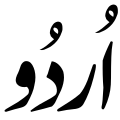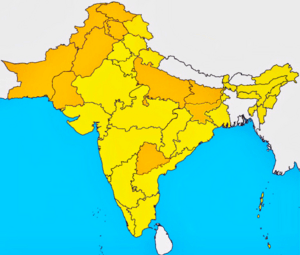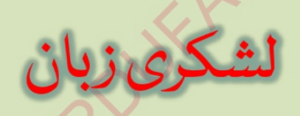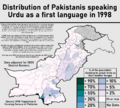Urdu facts for kids
Quick facts for kids Urdu |
||||
|---|---|---|---|---|
| اُردُو | ||||

Urdu in Nastaʿlīq script
|
||||
| Region | South Asia (native to the Hindi-Urdu Belt) | |||
| Ethnicity | None | |||
| Native speakers | 50.7 million in India 16 million in Pakistan (2007 and 2017) |
|||
| Language family |
Indo-European
|
|||
| Writing system |
|
|||
| Official status | ||||
| Official language in | Official: Secondary Official: |
|||
| Recognised minority language in | ||||
| Linguasphere | 59-AAF-q | |||

Areas where Urdu is either official or co-official Areas where Urdu is neither official nor co-official
|
||||
|
||||
Urdu is an Indo-Aryan language. It is also known as Lashkari. Urdu is the national language of Pakistan. Many people in Pakistan speak it as a common language. It is also spoken in parts of India, like Telangana, Andhra Pradesh, Delhi, Bihar, and Uttar Pradesh.
When people speak Urdu, it sounds very similar to Hindi. The main differences are some words, phrases, or the tone of speaking. However, when written, Urdu looks completely different from Hindi. This means that people who speak Hindi and Urdu can easily talk to each other. But they cannot read or write letters to each other because of the different writing systems.
Contents
What is the History of Urdu?
Urdu is thought to have started around the 11th century. This was in Lahore during the Ghaznavid Empire. It developed from an older language called Apabramsa. Urdu is a main form of the Hindustani language.
The word "Urdu" comes from the Chagatai language. In Chagatai, "urdu" means "army." Informal Urdu sounds exactly like modern informal Hindi. The main difference is some vocabulary. Hindi uses the Devanagari script, which comes from Sanskrit. Urdu uses the Persio-Arabic alphabet. It also uses many words from Persian and some from Arabic.
A poet named Ghulam Hamadani Mushafi first used the term 'Urdu' for this language in 1780. Over time, this led to a divide between the two main cultures in India and Pakistan: Muslims and Hindus. Hindus began to use Hindi, and Muslims started using Urdu. This also led to efforts to remove Sanskrit words from Urdu. Hindi speakers also wanted to remove Persian words from their language. In 1882, a group called Arya Samaj suggested that Urdu should be written in the Devanagari script. This started the Hindi-Urdu controversy. It further divided Urdu for Muslims and Hindi for Hindus.
How is Urdu Related to Persian?
Differences in Letters
The letters used in Urdu come from the Persian alphabet. The Persian alphabet itself comes from the Arabic alphabet. Urdu has some extra letters that are not in Persian. These include ٹ ,ڈ ,ڑ (ṫ, ḋ, ṙ). Two more letters were made for the sounds of ه (h) and ی (y). Adding these letters made the Urdu alphabet better for people in North India and Pakistan.
Similarities in Writing Style
Urdu is written from right to left, just like Persian (Farsi) script. Urdu is also written in the Nastaʿlīq style of Persian Calligraphy. Nastaʿlīq is a flowing, cursive writing style. It was created by Mīr ʿAlī of Tabrīz. He was a famous calligrapher during the Timurid period (1402–1502).
Understanding Formality in Urdu
Informal Urdu
When Urdu is spoken in a less formal way, it is sometimes called rekhta (ریختہ). This word means "rough mixture." The more formal style of Urdu is sometimes called zabān-e-Urdu-e-mo'alla. This means "Language of Camp and Court."
In everyday talk, it is called Lashkari Zabān (لشکری زبان). This means "military language" or "military tongue." It can be shortened to Lashkari.
The origin of a word in Urdu often shows how polite or formal your speech is. For example, Urdu speakers might use pānī (پانی) or āb (آب) for "water." They might use ādmi (آدمی) or mard (مرد) for "man." The word ādmi comes from Arabic and can mean "human being" (male or female). The word mard refers to a male gender or can mean "manly."
If a word comes from Persian or Arabic, the speech is seen as more formal. If Persian or Arabic grammar rules are used, the speech is also considered more formal and correct. If a word comes from Sanskrit, the speech is seen as more casual and personal. This might be because the Moghuls (Turks) influenced India. They considered Sanskrit a less important language than Persian or Urdu. For a long time, Persian was also the official language in areas controlled by the Moghuls.
Formal Urdu
Urdu is known for being a very polite language. Many words are used to show respect and politeness. This focus on politeness is called Aadab (courteous) or sometimes takalluf (formal) in Urdu. These words are mostly used when talking to older people or people you have not met before.
Famous Urdu Poets
Two very respected poets are Mirza Ghalib and Sir Mohammad Iqbal. They are celebrated in the Indian subcontinent and around the world.
Mirza Ghalib
Ghalib (1797-1869) is famous for his clever and sometimes funny poetry. Here is an example:
Umer bhar hum yun hee ghalati kartey rahen Ghalib Dhool ch-herey pei thee aur hum aaina saaf karte rahe
This translates to: O Ghalib (himself) all my life I kept making the same mistakes over and over, I was busy cleaning the mirror while the dirt was on my face.
Sir Mohammad Iqbal
Iqbal (1877-1938) was a poet and a politician. His poetry often talked about the struggles of the Muslim community. He bravely pointed out missing good qualities in society. Even though he faced opposition at first, he made a big impact. He is also called the “Poet of the East” and the “Poet of Islam.” Here is an example of his work:
Aapne bhe khafa mujh sei beganey bhe na khush Mein zeher -e-halahal ku kabhi keh na saka qand
This translates to: I could not keep happy either my loved ones nor the strangers, as I could never call a piece of poison a piece of candy.
Many people see Iqbal as an inspiring poet. He played a big part in the Pakistan Movement. Many believe he was the one who started it.
Common Urdu Words and Phrases
Here are some common phrases in Urdu:
- Formal Urdu: Aap tashreef rakhein = Please have a seat
- Informal Urdu: Aap bethein (You sit) or Tum betho (Sit, more informal)
- Formal Urdu: Me mu'azzarat chaahta/chaahti hun = Please excuse me/I apologize
- Informal Urdu: Me maafi chaahta/chaahti hun = I ask for forgiveness
- Aap kese hein? = How are you?
- Me theek hun = I am fine
- Assalam O Alaikum = Peace be upon you. This is a common greeting used in Islamic countries or among Muslims. It basically means "hello."
What is the Difference Between Urdu and Hindi?
Urdu is mainly spoken in Pakistan. Its grammar and sentence structures are very similar to Hindi. Hindi is mainly spoken in India. Because of this, people who speak Hindi and Urdu can easily have a conversation. Urdu and Hindi are very similar in spoken form.
Urdu gets most of its words and phrases from Persian and Arabic. These languages are spoken in Iran, Afghanistan, and many Middle Eastern countries. Urdu's written script also uses the Persian-Arabic alphabet. This is why Urdu speakers can read and write easily in Arabic and Persian. You can think of Urdu as a version of Hindi that has been influenced by Persian.
Names of colors, objects, feelings, and more can be different in Urdu than in Hindi. The Persian words are often used in books, shows, and poetry. These words are seen as more formal and "Urdu." However, informal Urdu, which is spoken among family and friends in Pakistan, often uses Hindi words for many things. This is because Pakistan and India were once one country until they split in 1947. So, in daily informal talks, it can be hard to tell an Urdu speaker from a Hindi speaker. You might only notice if they use words specific to their language. That is why you often see YouTube videos or movies listed as "Urdu/Hindi." But books and articles will not say "Urdu/Hindi" because the two languages use completely different writing systems.
You can imagine Urdu as British English written with Chinese letters. And Hindi as American English written with Egyptian hieroglyphs. But with more differences in vocabulary and fewer differences in how words are pronounced.
Other Sources
- Encyclopædia Britannica Nastaʿlīq script
Images for kids
-
A multilingual New Delhi railway station board. The Urdu and Hindi texts both read as: naī dillī.
-
An English-Urdu bilingual sign at the archaeological site of Sirkap, near Taxila. The Urdu says: (right to left) دو سروں والے عفاب کی شبيہ والا مندر, dō sarōñ wālé u'qāb kī shabīh wāla mandir. "The temple with the image of the eagle with two heads."
See Also
 In Spanish: Urdu para niños
In Spanish: Urdu para niños








